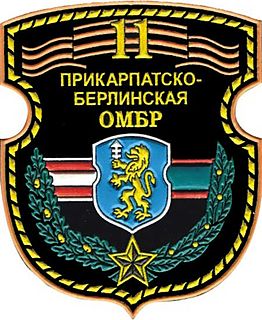
The 8th Guards Order of Lenin Combined Arms Army is an army of the Russian Ground Forces, headquartered in Novocherkassk, Rostov Oblast, within Russia′s Southern Military District, that was reinstated in 2017 as a successor to the 8th Guards Army of the Soviet Union's Red Army, which was formed during World War II and was disbanded in 1998 after being downsized into a corps.

The 3rd Guards Army was a field army of the Soviet Red Army that fought on the Eastern Front in World War II.

The 3rd Ukrainian Front was a Front of the Red Army during World War II.
The 3rd Guards Volnovakha Red Banner Order of Suvorov Motor Rifle Division was a division of the Soviet Army from 1957 to around 1992. It traced its history from the highly decorated 3rd Guards Rifle Division of World War II. 3rd Guards Rifle Division was formed from the 153rd Rifle Division.
The 27th Guards Motor Rifle Division was a Red Army rifle division in World War II which later became a Soviet Army motor rifle division.

The 4th Guards Airborne Division was an airborne division of the Red Army that fought as infantry during World War II.
The 79th Guards Rifle Division was an infantry division of the Red Army during World War II.
The 31st Rifle Division was an infantry division of the Soviet Union's Red Army during the interwar period and World War II.
The 46th Army was a Soviet Red Army field army during World War II. The army was formed in August 1941 and guarded the Turkish border. During the summer of 1942, it fought in the Battle of the Caucasus. During the spring of 1943, the army helped capture Maykop and Krasnodar. During the summer of 1943, it fought in the Donbass Strategic Offensive and the Battle of the Dnieper. During early 1944, it fought in the Nikopol–Krivoi Rog Offensive and the Odessa Offensive. During the summer it fought in the Jassy–Kishinev Offensive. The army advanced westward and participated in the Battle of Debrecen and Budapest Offensive during the fall. After the fall of Budapest in February 1945, the army fought in the Vienna Offensive and the Prague Offensive. During the summer of 1945 the army moved to the Odessa Military District and was disbanded in September.

The 11th Guards Mechanized Brigade is a unit of the Armed Forces of Belarus based in Slonim. The 11th Guards Brigade traces its history back to the 1942 formation of the 6th Tank Corps of the Soviet Army during World War II.
The 11th Guards Rifle Division was a rifle division of the Red Army during the Great Patriotic War. It was disbanded in 1946.

The Nikopol–Krivoi Rog Offensive was an offensive by the Red Army's 3rd Ukrainian Front and elements of the 4th Ukrainian Front against the German 6th Army in the area of Nikopol and Krivoi Rog in Dnipropetrovsk Oblast in central Ukraine between 30 January and 29 February 1944. It took place on the Eastern Front of World War II and was part of the wider Dnieper–Carpathian Offensive, a Soviet attack against Army Group South to retake the rest of Ukraine that fell to Germany in 1941.

The 35th Guards Rifle Division was a division of the Soviet Red Army in World War II.

Ilya Arkhipovich Vlasenko was a political commissar in the Red Army during and following World War II. Vlasenko was awarded the title Hero of the Soviet Union in 1943 for his leadership in the Battle of the Dnieper.
Aslan Farhad oglu Vazirov was an Azerbaijani Red Army colonel and Hero of the Soviet Union. Vazirov served in the Red Army's engineer troops during the interwar period. In 1941 and 1942 Vazirov served with the 18th Army's engineering troops. In that year he became commander of the 38th Separate Engineering Regiment. During the Battle of the Caucasus he led the 5th Mountain Mine-Engineer Brigade. In June 1943 he became commander of the 51st Engineer-Sapper Brigade. He commanded the 1st Guards Assault Engineer-Sapper Brigade from May 1944. Vazirov was awarded the title Hero of the Soviet Union on 29 June 1945 for his leadership of the brigade during the Berlin Offensive. Vazirov retired in 1947 and lived in Baku. He became a deputy of the Supreme Soviet of the Azerbaijan SSR and was chairman of the Baku chapter of the Soviet Committee of War Veterans.
The 5th Guards Anti-Aircraft Artillery Division was an anti-aircraft artillery division of the Soviet Union's Red Army during World War II.
The 3rd Anti-Aircraft Artillery Division was an anti-aircraft artillery division of the Soviet Union's Red Army during World War II.
The 82nd Rifle Corps was a rifle corps of the Red Army and later the Soviet Army.
The 4th Guards Motor Rifle Division was a motorized infantry division of the Soviet Army during the Cold War.
The 36th Guards Rifle Division was a Guards infantry division of the Red Army during World War II. It was formed from the 9th Airborne Corps in August 1942 as a result of the Soviet need for troops to fight in the Battle of Stalingrad. The division was awarded the honorific Verkhnedneprovsk for its crossing of the Dnieper in September 1943 near that town, later receiving the Order of the Red Banner and the Order of Suvorov, 2nd class, for its actions in the Uman–Botoșani Offensive in March 1944. It fought in the Siege of Budapest during late 1944 and early 1945, receiving the Order of Kutuzov, 2nd class, for its actions. In late 1945, it was converted into the 24th Guards Mechanized Division. Stationed in Romania, it was disbanded in early 1947.







